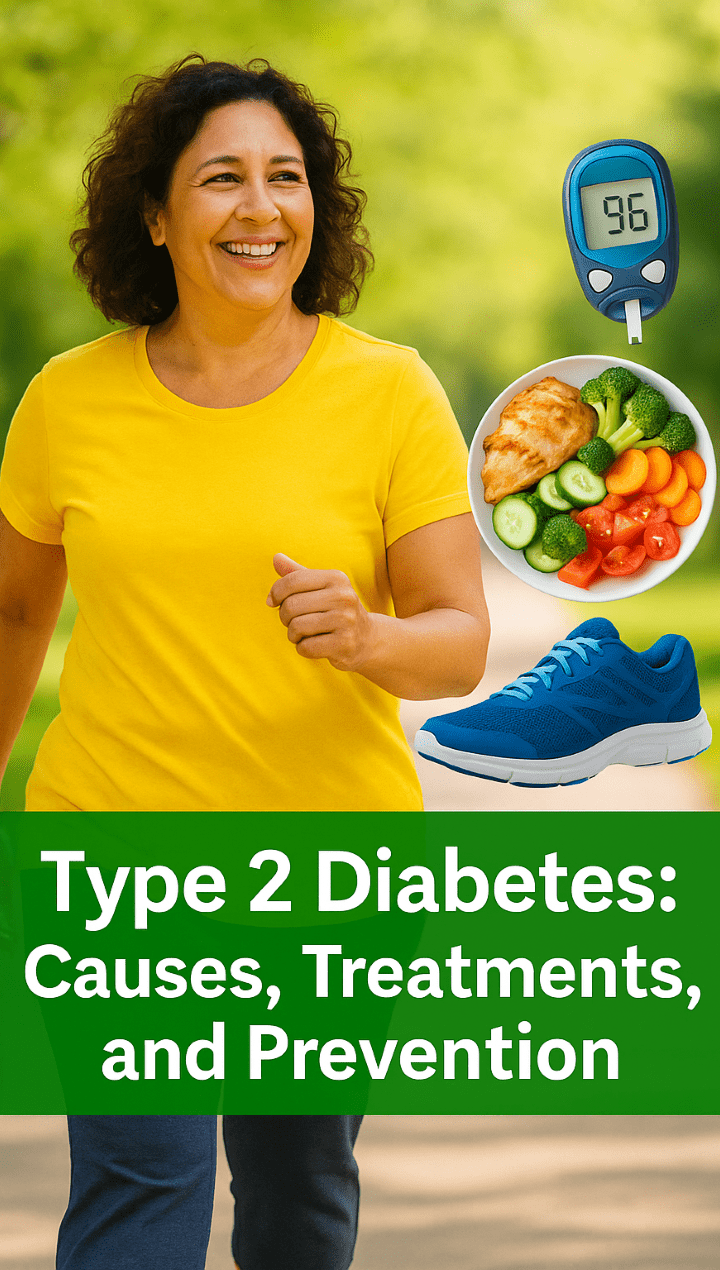Type 2 Diabetes is a common condition where blood sugar levels get too high. It arises when your body mishandles or under produces insulin. This can lead to health problems, but you can manage it with healthy habits, medicines, and regular checkups. In this guide, we’ll explore what causes type 2 diabetes, how to treat it, and ways to prevent it, so you can live a healthier life.
What Is Type 2 Diabetes?
A chronic disorder that disrupts sugar metabolism: poor insulin leads to persistently high blood sugar. I’ve seen people live well with Type II diabetes by making minor changes, like eating better and moving more.
Causes of Type 2 Diabetes
The exact cause of Type II diabetes isn’t fully clear, but it’s linked to a mix of genetics and lifestyle factors. Here’s what contributes to it:
1. Insulin Resistance
In type 2 diabetes, muscle, fat, and liver cells become insulin resistant, so sugar uptake drops and blood sugar rises. I’ve noticed this is common in people who are overweight.
2. Insufficient Insulin Production
Insufficient pancreatic insulin hinders blood sugar regulation. This happens over time, especially if the body is insulin resistant. It’s like the pancreas gets tired keeping up.
3. Risk Factors
Certain things increase your chance of getting Type II diabetes:
- Being overweight: Extra weight, especially around the belly, makes insulin resistance worse.
- Lack of exercise: Not moving enough reduces insulin sensitivity.
- If an immediate family member has type 2 diabetes, your risk increases.
- Age: Risk goes up after age 45, but younger people can get it too.
- Unhealthy diet: Eating lots of sugary or processed foods raises your risk.
- Individuals with African, Hispanic, Native American, or Asian roots face a higher risk.
I like how understanding these risks helps people act early
Symptoms of Type 2 Diabetes
The signs progress slowly, so you may miss them at first. Many people remain unaware they’re affected. Here are common signs to watch for:
- Increased thirst and urination: High blood sugar makes your body flush out sugar through urine, making you thirsty and pee more.
- Fatigue: Cells can’t use glucose well, leaving you tired.
- Excess glucose can swell your lens, clouding your vision.
- Slow-healing wounds: Poor blood flow and a weaker immune system slow healing.
- Frequent infections: High sugar levels make skin, urinary, or gum infections more likely.
- Tingling or numbness: Long-term high blood sugar can damage nerves, especially in the hands and feet.
- Unexpected weight loss: When sugar isn’t used, the body burns fat or muscle.
If you notice these Type II diabetes symptoms, talk to a doctor. I’ve seen people catch it early and avoid bigger problems.
Complications of Type 2 Diabetes
Unchecked type 2 diabetes can lead to grave complications. Here’s what could happen:
Read more about: Type 2 Diabetes Complications and Prevention Tips: Expert Guide
| Complication | What It Means |
| Heart disease | Increase risk of heart attacks and strokes due to damaged blood vessels. |
| Kidney disease | High blood sugar harms kidneys, possibly leading to dialysis or failure. |
| Nerve dysfunction. | It leaves hands and feet numb, sore, or weak. |
| Ocular injury. | Harms ocular vessels, risking blindness. |
| Foot problems | Poor blood flow and nerve damage can cause sores or infections, risking amputation. |
| Cutaneous concerns. | Heightens vulnerability to infections and skin irritation. |
| Tooth and gum issues | Boosts the chances of gum issues or losing teeth. |
| Depression | Managing type 2 diabetes can feel stressful, raising the risk. |
Diabetes Type 2 management can prevent or delay these issues. I’ve seen people thrive by staying on top of their care.
Treatments for Type 2 Diabetes
Managing Diabetes Type II involves keeping blood sugar levels in a healthy range. Usually involves healthy habits, meds, and routine visits.
. Here’s how it works:
1. Lifestyle Changes
Healthy habits are the foundation of Type II diabetes treatment. Try these:
- Energize your body with fresh produce, whole grains, and lean protein.
- Avoid sugary drinks and processed snacks. I like this because it’s doable and makes you feel good.
- Exercise regularly: Aim for 30 minutes most days, like walking or dancing. It boosts insulin sensitivity.
- Drop 5–10% of your body mass to lower blood sugar.
- Quit smoking: Smoking worsens Type II diabetes complications.
- Limit alcohol: Stick to moderate amounts to avoid blood sugar spikes.
2. Medications
If lifestyle changes fall short, your doctor might suggest medications.
- Metformin cuts liver sugar and ups insulin response.
- Sulfonylureas: Boost pancreatic insulin output.
- DPP-4 inhibitors:
- GLP-1 drugs raise insulin and slow sugar uptake.
- Some also aid weight loss.
- SGLT2 inhibitors: Help kidneys remove sugar through urine.
- Insulin therapy: Used if other medicines don’t work, especially in advanced cases.
I’ve seen people feel empowered when their medicines and habits work together.
3. Monitoring Blood Sugar
Regularly check your blood glucose to monitor type 2 management.
You can use:
- A glucose meter at home.
- A continuous glucose monitor (CGM) for real-time readings.
Your doctor will tell you about the target ranges. I like CGMS because they’re easy and give clear data.
4. Regular Checkups
See your doctor every 3–6 months to monitor:
- Blood sugar levels (A1C test).
- Blood pressure and cholesterol.
- Kidney, eye, and foot health.
These visits catch problems early. Routine checkups boost people’s sense of control.
5. Education and Support
Learn about type 2 diabetes through classes or support groups. Understanding blood sugar control and complication prevention helps you stay motivated. I’ve seen support groups make an enormous difference for people feeling overwhelmed.
When to See a Doctor
Managing type 2 diabetes is easier with a doctor’s help, especially if you’re sick. Colds and similar ailments can disrupt blood sugar. Create a sick day plan with your doctor, including:
- How often do I check my blood sugar?
- When to adjust medicines.
- What to eat or drink?
Call your doctor right away if you have:
- A fever of 100°F (38°C) or higher.
- Blood sugar has been consistently high for over 24 hours.
- Nausea or vomiting for more than 4 hours.
- Confusion, memory loss, or coordination issues.
- Severe pain or inability to move arms/legs.
I’ve seen quick doctor calls prevent serious issues during sick days.
Preventing Type 2 Diabetes
You can lower your risk of Type II diabetes with healthy choices. Here’s how:
- Keep your weight in check—even a small drop cuts risk.
- Aim for a healthy BMI.
- Choose whole fruits, veggies, and lean protein.
- Limit sugary snacks.
- Stay active: Exercise 150 minutes a week, like brisk walking, to improve insulin sensitivity.
- Quit smoking: Smoking raises Type II diabetes. Quitting helps your overall health.
- Limit alcohol: Stick to moderate drinking to avoid blood sugar spikes.
- Manage stress: Try yoga or meditation to keep stress management in check, as stress can raise blood sugar.
- Get regular checkups: Screen for prediabetes or early type 2 diabetes with blood tests.
- Monitor blood sugar: If you’re at risk, check levels to catch issues early.
I like these diabetes prevention tips because they’re practical and improve your whole life.
FAQS About Type 2 Diabetes
What is type 2 diabetes?
Insulin resistance or shortage spikes blood sugar; treat it with lifestyle, meds, and checkups. I’ve seen people control it well with effort.
Is type 2 diabetes life-threatening?
If uncontrolled, it may trigger heart, kidney, or nerve issues. With blood sugar control, risks drop. Call a doctor about severe symptoms like confusion or high fever.
How do you control type 2 diabetes?
Control Type II diabetes with:
- A healthy diet is full of whole foods.
- Regular physical activity, like walking.
- Medicines or insulin, if prescribed.
- Routine blood sugar checks and doctor visits.
It occurs when your body resists or under produces insulin.
What physical effects does type 2 diabetes have?
Sustained high sugar harms your heart, kidneys, eyes, nerves, and feet, yet smart habits—diet, exercise, and meds—can prevent damage.
Final Thoughts
Type 2 Diabetes is a challenge, but you can manage it with the right tools. By understanding its causes, following Type II diabetes treatment plans, and making healthy choices, you can live well. Whether it’s eating better, moving more, or checking in with your doctor, every step counts. I’ve seen people transform their lives with these diabetes prevention tips and treatments, and I know you can too.
Talk to a doctor if you’re worried about Type II diabetes or notice symptoms. Share this guide to others and let me know in the comments if you have questions. You’ve got this—keep taking care of yourself!
Reference
Diabetes UK” – Official website of a leading diabetes charity in the UK. Website: www.diabetes.org.uk
“NHS: Type 2 diabetes” – Information about Type 2 diabetes from the UK’s National Health Service. Website: www.nhs.uk/conditions/type-2-diabetes



